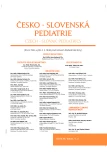Family Eating and Activity Habits Questionnaire – reliability verification
Authors:
I. Klimešová; M. Elfmark; P. Králová
Authors‘ workplace:
Katedra přírodních věd v kinantropologii, Fakulta tělesné kultury UP, Olomouc
Published in:
Čes-slov Pediat 2020; 75 (2): 78-81.
Category:
Original Papers
Overview
Objective: To verify the reliability of the Czech version of the Family Eating and Activity Habits Questionnaire (SPZR).
Methods: A three-day and a three-week interval of test and re-rests were used to verify the stability of the SPZR questionnaire over time. The research sample consisted of 47 families with children aged 6–12 years.
Results: For individual family members (mother, father and child), the test-retest correlation coefficients for each scale and total score of the questionnaire ranged from 0.887 to 0.984 after 3 days and 0.781 to 0.980 after 3 weeks. The test-retest correlation coefficients of the total SPZR score for the whole family were after 3 days 0.982 and 0.980 after 3 weeks.
Conclusion: The questionnaire has a very good reliability.
Keywords:
obesogenic environment – test standardization – questionnaire SPZR – family environment assessment – test-retest
Sources
1. Jaeschke L, Steinbrecher A, Luzak A, et al. Socio-cultural determinants of physical activity across the life course: a ‘Determinants of Diet and Physical Activity’ (DEDIPAC) umbrella systematic literature review. Int J Behav Nutr Phys Act 2017; 14 (1): 173.
2. Xu C, Quan M, Zhang H, et al. Impact of parents’ physical activity on preschool children’s physical activity: a cross-sectional study. PeerJ 2018; 6: e4405.
3. Birch LL, Davison KK. Family environmental factors influencing the developing behavioral controls of food intake and childhood overweight. Pediatr Clin North Am 2001; 48: 893–907.
4. Maitland C, Stratton G, Foster S, et al. A place for play? The influence of the home physical environment on children’s physical activity and sedentary behaviour. Int J Behav Nutr Phys Act 2013; 10 (1): 99.
5. Northstone K, Emmett PM. Are dietary patterns stable throughout early and mid-childhood? A birth cohort study. Br J Nutr 2008; 100: 1069–1076.
6. Golan M, Weizman A. Reliability and validity of the Family Eating and Activity Habits Questionnaire. Eur J Clin Nutr 1998; 52 (10): 771–777.
7. Golan M. Fifteen years of the Family Eating and Activity Habits Questionnaire (FEAHQ): an update and review. Pediatr Obes 2013; 9 (2): 92–101.
8. Klimešová I, Stelzer J, Miklánková M. Family Eating and Activity Habits Questionnaire – český překlad a ověření srozumitelnosti dotazníku. Čes-slov Pediat 2018; 73 (8): 494–500.
9. Hopkins WG, Marshall SW, Batterham AM, Hanin J. Progressive statistics for studies in sports medicine and exercise science. Med Sci Sport Exerc 2009; 41 (1): 3–13.
10. Nielsen LA, Nielsen TRH, Holm J-C. The Impact of familial predisposition to obesity and cardiovascular disease on childhood obesity. Obes Facts 2015; 8 (5): 319–328.
11. Wilfley DE, Tibbs TL, Van Buren D, et al. Lifestyle interventions in the treatment of childhood overweight: A meta-analytic review of randomized controlled trials. Heal Psychol 2007; 26 (5): 521–532.
12. Bryant MJ, Ward DS, Hales D, et al. Reliability and validity of the Healthy Home Survey: a tool to measure factors within homes hypothesized to relate to overweight in children. Int J Behav Nutr Phys Act 2008; 5: 23.
13. Gattshall ML, Shoup JA, Marshall JA, et al. Validation of a survey instrument to assess home environments for physical activity and healthy eating in overweight children. Int J Behav Nutr Phys Act 2008; 5: 3.
14. Anderson SE, Must A, Curtin C, Bandini LG. Meals in our household: reliability and initial validation of a questionnaire to assess child mealtime behaviors and family mealtime environments. J Acad Nutr Diet 2012; 112: 276–284.
15. West F, Sanders MR. The lifestyle behavior checklist: a measure of weight-related problem behavior in obese children. Int J Pediatr Obes 2009; 4: 266–273.
16. Roberts K, Flaherty SJ. Review of Dietary Assessment Methods in Public Health. Oxford: National Obesity Observatory, 2010. https://dl-web.dropbox.com/get/References/Dietary Assessments/NOO 2010 – Review of dietary assessment methods in public health.pdf?w=64e15d9e.
Labels
Neonatology Paediatrics General practitioner for children and adolescentsArticle was published in
Czech-Slovak Pediatrics

2020 Issue 2
Most read in this issue
- Foreign bodies in the swallowing pathways in children
- Successful ultrasound-guided percutaneous ethanol injection therapy of thyroid cysts in adolescents
- Aspiration of the foreign bodies in children – case reports
- Treatment of thrombosis in newborns and infants
